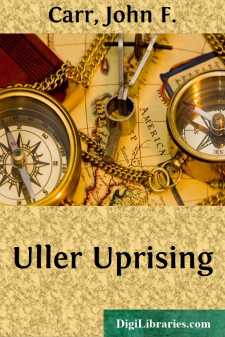Categories
- Antiques & Collectibles 13
- Architecture 36
- Art 48
- Bibles 22
- Biography & Autobiography 813
- Body, Mind & Spirit 142
- Business & Economics 28
- Children's Books 15
- Children's Fiction 12
- Computers 4
- Cooking 94
- Crafts & Hobbies 4
- Drama 346
- Education 46
- Family & Relationships 57
- Fiction 11828
- Games 19
- Gardening 17
- Health & Fitness 34
- History 1377
- House & Home 1
- Humor 147
- Juvenile Fiction 1873
- Juvenile Nonfiction 202
- Language Arts & Disciplines 88
- Law 16
- Literary Collections 686
- Literary Criticism 179
- Mathematics 13
- Medical 41
- Music 40
- Nature 179
- Non-Classifiable 1768
- Performing Arts 7
- Periodicals 1453
- Philosophy 64
- Photography 2
- Poetry 896
- Political Science 203
- Psychology 42
- Reference 154
- Religion 513
- Science 126
- Self-Help 84
- Social Science 81
- Sports & Recreation 34
- Study Aids 3
- Technology & Engineering 59
- Transportation 23
- Travel 463
- True Crime 29
Uller Uprising
by: John F. Carr
Categories:
Description:
Excerpt
Introduction to
ULLER UPRISING
by John F. Carr
With the publication of this novel, Uller Uprising, all of H. Beam Piper's previously published science fiction is now available in Ace editions. Uller Uprising was first published in 1952 in a Twayne Science Fiction Triplet—a hardbound collection of three thematically connected novels. (The other two were Judith Merril's Daughters of Earth and Fletcher Pratt's The Long View.) A year later it appeared in the February and March issues of Space Science Fiction, edited by Lester Del Rey.
The magazine version, which was abridged by about a third, was believed by many bibliographers to be the only version—and as a novella it was too short for book publication. The Twayne version had a small print run and is so scarce that few people have seen it. Those bibliographers who knew of its existence assumed that both versions of Uller were the same. It was through a telephone conversation with Charles N. Brown, publisher of Locus and correspondent with Piper, that I learned about the Twayne edition and its greater length. Brown allowed me to photocopy his original, for which we owe him a debt of thanks; because the Twayne version is not only novel length, but far better than the shorter one that appeared in Space Science Fiction.
Probably the most surprising and interesting thing about the Twayne edition is the essay that forms the introduction to that volume, and is reprinted here. The essay is by Dr. John D. Clark, an eminent scientist of the forties and fifties and one of the discoverers of sulfa, the first "miracle drug." It describes in great detail the planetary system of the star Beta Hydri, and gives the names of those planets: Uller and Niflheim. A publisher's note states that Clark's essay was written first, and given to the contributors as background material for a novel they would then write.
The fans of H. Beam Piper seem to owe a great debt to Dr. Clark. Uller Uprising became the foundation of Piper's monumental Terro-Human Future History; the first story where we encounter the Terran Federation. In it we learn about Odin, the planet that will one day be the capital of the First Galactic Empire; and humble Niflheim, which in more decadent times will become a common expletive, a word meaning hell. This is also where Piper introduced and explained the Atomic Era dating system (A.E.). Uller Uprising is set in the early years of the Terran Federation's expansion and exploration, an epoch of great vitality. In "The Edge of the Knife" Piper compares this time of discovery to the Spanish conquest of the Americas. This feeling of vigor and unlimited possibilities runs through all the early Federation stories: Uller Uprising, "Omnilingual," "Naudsonce," "When in the Course—," and, to a lesser degree, in the late Federation novels, Little Fuzzy, Fuzzy Sapiens, and Fuzzies and Other People. (See Federation by H. Beam Piper for a good overview of this period.)
In these stories we see Terro-Humans at their best and at their worst: Individual heroism and bravery in the face of grave danger in Uller Uprising; Federation law and justice in Little Fuzzy and its sequels; and, in "Omnilingual" and "Naudsonce," the spirit of science and rational inquiry. Yet we also see colonial exploitation and subjugation in Uller Uprising and "Oomphel in the Sky," the greed and corruption of Chartered land companies in Little Fuzzy, and political corruption in Four-Day Planet. These stories are about a living Terro-Human culture, not a utopia.
It was Piper's attention to historical realism and his use of actual historical models that have helped his work to pass the test of time and have led to his becoming the favorite of a new generation of readers more than twenty-five years after his death.
Uller Uprising is the story of a confrontation between a human overlord and alien servants, with an ironic twist at the end. Like most of Piper's best work, Uller Uprising is modeled after an actual event in human history; in this case the Sepoy Mutiny (a Bengal uprising in British-held India brought about when rumors were spread to native soldiers that cartridges being issued by the British were coated with animal fat. The rebellion quickly spread throughout India and led to the massacre of the British Colony at Cawnpore.)....


